#educationandtechnology
Explore tagged Tumblr posts
Text
Confluence 2023: AI in Education - Shaping the Future of Learning - Bhopal
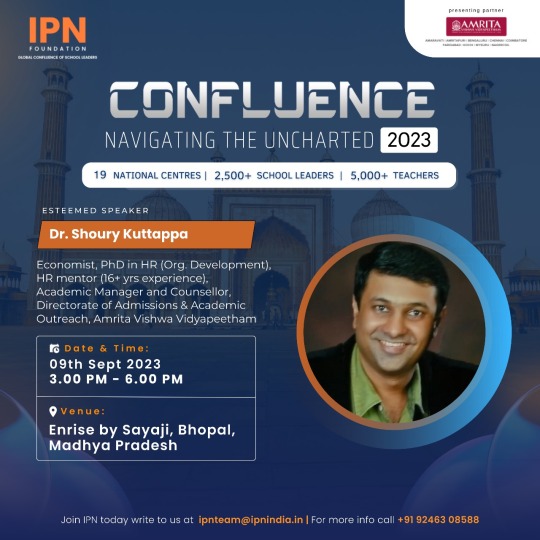
The Confluence 2023: Navigating the Uncharted - Artificial Intelligence in Education and Learning event held in Bhopal was a resounding success, drawing a distinguished audience of principals and school directors interested in exploring the transformative role of AI in education.
Dr. Shoury Kuttappa, a prominent authority on AI and educational innovation, led the event with insightful sessions that explored the vast potential of artificial intelligence to redefine learning and school leadership. His presentations focused on how AI-powered tools can revolutionize teaching by personalizing the learning journey, using adaptive learning systems, and leveraging data-driven insights for improved student engagement and outcomes.
Dr. Shoury Kuttappa emphasized that AI offers the chance to fulfill the evolving meaning of education—supporting not only academic success but also critical thinking, creativity, and real-world skills. His approach helped participants navigate the complexities and ethical dimensions of AI integration in schools, ensuring that it complements the human aspect of teaching.
Attendees were empowered with strategies for utilizing AI in classroom environments, aligning with educational goals, and fostering inclusive, innovative learning spaces. The event successfully equipped school leaders with the tools and vision necessary to embrace technology-enhanced education, preparing them to lead with confidence in an AI-driven future.
#AIinEducation#FutureOfLearning#EducationAndTechnology#RedefiningEducation#21stCenturyLearning#LeadershipInEducation#TransformingTeaching#InnovativeEducation#PersonalizedLearning#SchoolLeadership#EducationalInnovation#EmpoweringEducators#AdaptiveLearning#TechnologyInEducation#GrowthMindset#LeadershipDevelopment#DrShouryKuttappa
0 notes
Text
AI Button: Bridging Education, Technology, and Public Welfare
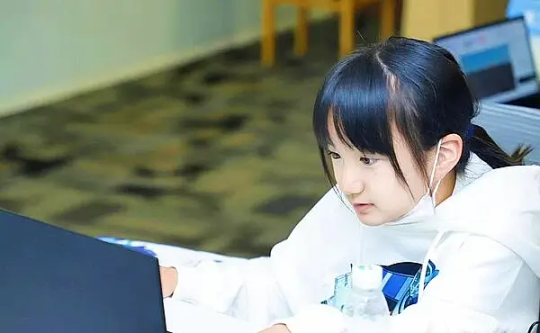
Transforming Education with AI
In an era where technology is revolutionizing every aspect of our lives, 13-year-old high school student Qiu Yumo is at the forefront of change. With the creation of AI Button, an innovative platform blending education, technology, and public welfare, Qiu Yumo has taken a significant step toward redefining learning for students worldwide. A Visionary Concept AI Button is a visionary project that underscores the importance of long-term commitment to education. As governments and international organizations increasingly strive for educational equality, the education industry is experiencing a surge in attention. UNESCO's Education 2030 Agenda, aimed at achieving global educational equity and inclusive education, serves as a testament to these efforts. The Birth of AI-Button Born from the mind of a middle school student, AI-Button represents a transformative tool platform. It harnesses the power of AI's big model to support public welfare education, seamlessly merging learning, philanthropy, and socialization. Students can utilize this platform to enhance their educational journey and contribute to societal betterment. Personalized Learning Assistance AI-Button's core functionality is its AI-powered personal learning assistant. By simply inputting their learning materials, students receive tailored guidance and advice, enhancing their learning and review processes. Whether they're consolidating previous knowledge or preparing for exams, AI-Button ensures students have access to precise materials and recommendations. This online mentor is available 24/7 and accommodates both Chinese and English languages.
Fostering Philanthropy and Social Responsibility
Beyond its educational capabilities, AI Button encourages students to engage in philanthropic activities. It seamlessly blends education, socialization, and public welfare, offering students a multifaceted experience. Students can record various public welfare projects on the platform, earning platform points for their participation. This innovative approach stimulates interest in philanthropy, fosters teamwork, and nurtures a sense of responsibility. Empowering Students AI-Button's impact on students is profound. Many have eagerly participated in online projects, finding AI-Button to be an enthusiastic learning companion. Students report increased enthusiasm for learning and engagement in public welfare initiatives. Moreover, they gain a deeper appreciation for technology's role in facilitating learning and societal progress, all while building lasting friendships.
The Remarkable Journey of Qiu Yumo
The visionary behind AI-Button, Qiu Yumo, embarked on her programming journey at the tender age of 6. By age 7, she had already developed a successful game. Qiu Yumo's fascination with AI and its transformative potential led her to explore AI's capabilities. In early 2023, she combined her passion for programming with her love for pets to create a pet pedometer, a project that garnered recognition at a school science exhibition. A Lifelong Commitment to Philanthropy Qiu Yumo's journey in philanthropy began at the age of 4 when she organized a charity sale at her kindergarten. Over the years, she consistently engaged in various philanthropic activities. Her commitment culminated in her decision to donate her hair to children with cancer on her 13th birthday. Qiu Yumo epitomizes the spirit of philanthropy, continually using her talents and creativity to make a positive impact.
A 99 Public Welfare Project
In 2023, Qiu Yumo's popular creation, AI Button, became a catalyst for her 99 public welfare project. Determined to influence more students and amplify her support for public welfare initiatives, she leveraged AI-Button's potential to make a difference. However, the journey from creating "a small tool for myself" to transforming it into a platform serving hundreds was no small feat. Collaborative Efforts Qiu Yumo's dedication inspired a team of students from different schools to join the AI-Button project. Their collective efforts spanned testing, optimization, promotion, and collaboration. Weekly meetings ensured the synchronization of their progress. After months of iterative development and refinement, AI-Button matured into a user-friendly platform, opening its doors to eager learners.
A Vision for the Future
AI-Button's ultimate goal is to seamlessly integrate technology, public welfare, and education. It aims to create a mutually beneficial learning environment, empowering students to maximize technological resources for efficient learning. This platform encourages active participation in public welfare endeavors, fostering social responsibility and teamwork while igniting an interest in technology and learning. Promoting Educational Equity Education experts applaud AI-Button's mission to provide a high-quality learning and growth environment, especially for students in underserved areas. This innovative approach embodies the potential of technology and education to promote educational equity. It showcases the creative synergy between technology and education, highlighting the sparks of ingenuity in this evolving landscape. Sources: THX News & AI-Button. Read the full article
#13-year-oldtechinnovator#AIButton#AI-poweredlearningplatform#Educationandtechnology#Educationalequitythroughtechnology#LearningwithAI#Personalizededucationassistance#Philanthropicstudentinitiatives#Philanthropyineducation#QiuYumo
0 notes
Text
Importance of educational technology in todays ed. industry
“Every business will become a software business.” Satya Nadela repeated in Microsoft’s annual CONVERGENCE CONFERENCE in 2015. Nadella believed these activities would fundamentally change the economics of business, using what he called “systems of intelligence”.
We Cannot Escape Technology!
We have seen that the world has changed at the speed of light since technology took over our lives. Digitalization has changed how the world will look in 20-30 years. Accompanying digitalization is artificial intelligence taking over sectors such as defense and health care. Blockchain technology, and augmented reality, are soon becoming a part of the technological revolution; and will be the force that will drive us into the future.
21st-century educators must see their role in a new light. Education facilitators must see themselves as designers of learning experiences using great learning apps. Educators must design learning experiences that use technology to access information and allow students to connect with the world. The advantage of digital technology is that it operates in real time. Hence, the routines are malleable and changeable, and the work processes transform because of flexibility. Digital technology, Cloud- computing, and data analytics were unavailable until the last decade. And because of the acceleration of digital technology, cloud computing, data analytics, social media, and mobile computing, it is an upheaval- an overhaul.
No country can ignore the necessity of switching to automation and artificial intelligence. Artificial intelligence and automation have become sources of productivity to secure high-quality economic growth in the U.S and across the globe. Technology is now considered an essential constituent to lift the economy and add impetus to the progress of a nation.
0 notes
Photo

Queen Elizabeth II greets Emperor Akihito of Japan and Empress Michiko as they arrive at a lunch for Sovereign Monarch’s held in honour of Queen Elizabeth II’s Diamond Jubilee at Windsor Castle on May 18, 2012.
Source: WPA Pool | Getty Images Europe
#AMeetingOfMinds #UnitedKingdomAndJapan #EducationAndTechnology
0 notes
Photo

On today's menu we have virtual reality training improving social skills and brain activity of young adults with autism.
We know that individual with autism struggle with the lack of social skills, here is an amazing research that is helping young adults to cope and engage more with our extremely detailed and complicated social rules.
Twice a week, each of the young adults in Daniel Yang’s study spends an hour inside a virtual world. A webcam projects his or her facial expressions onto a digital avatar that interacts with the avatar of an autism therapist.
One or more virtual characters join in as the therapist presents the day’s situation. It may be a job interview, a new neighbor or a blind date. The counselor also describes the social skills they’ll be practicing. The task may involve recognizing the unspoken intentions behind a behavior or sharing an opinion in a socially acceptable way.
With funding from Autism Speaks, Dr. Yang and his team hope to improve the Virtual Reality Social Cognition Training program’s effectiveness in teaching social skills to adults with autism spectrum disorder. In the first phase of the study, they are evaluating how well the program improves social understanding. Using brain imaging and brain-wave monitoring, they’re also tracking whether and how the program changes brain activity and connections between brain regions involved in social behavior.
“Our early results are beginning to reveal a remarkable degree of malleability in the neural systems involved in social cognition in adults with ASD,” he says. Lay translation: On brain scans performed after the training, the researchers are seeing brain regions associated with social understanding literally light up in ways they hadn’t before. (See images below.)
After the virtual reality training, young adults with autism showed increased activation in brain regions associated with social understanding.
After the virtual reality training, the researchers saw increased connectivity between brain regions that exchange information during effective social interactions.They’re also seeing new connections form between brain regions that need to exchange information during an effective social interaction. (See images at right.)
Presentation at Neuroscience 2014 Dr. Yang, an Autism Speaks Meixner Postdoctoral Fellow, presented his study’s preliminary findings on Sunday, at Neuroscience 2014, the world’s largest annual gathering of brain researchers. Dr. Yang’s fellowship mentors include Yale neuroscientist Kevin Pelphrey.
So far, four participants with autism (three men and one woman, between age 18 and 35) have completed the 5-week training and undergone the before-and-after brain monitoring and social-understanding testing. In all, Dr. Yang hopes to complete the testing with 48 young men and women with autism. Participants are verbal and have typical or above-average IQ.
For comparison, Dr. Yang is also enrolling young adults not affected by autism. So far, two men and two women have completed the testing.
Pre- and post-training test results To gauge changes in social awareness and understanding, the participants watch an animation of two “dancing” triangles. In some cases, the triangles move randomly. In others, their movements suggest an interaction. (Watch the dancing triangles animation task here.)
After virtual reality training, young adults with autism performed better at discerning random movement versus interaction in an animation of two "dancing" triangles.After the virtual-reality training, the participants with autism were better able to discern the “interacting” triangles from those moving randomly. They also improved in their ability to identify the kinds of interactions the triangles were mimicking (teasing, chasing, etc.).
While the participants perform the task, the researchers monitor their brain activity with functional magnetic resonance imaging (fMRI). The fMRI reveals the location and degree of brain activity. Importantly, Dr. Yang says, the increased brain activity and connections seen after the virtual-reality training more-closely resemble the brain activity seen in the four “neurotypical” adults serving as controls.
In addition, the researchers will use electroencephalography (EEG) to track whether different areas of the brain respond more quickly, or efficiently, to social cues. Dr. Yang and his team are still analyzing the results of their first EEGs.
“Virtual reality and avatar-based programs may be especially promising for people with autism who are uncomfortable in social interactions where subtle social cues are important,” comments Daniel Smith, Autism Speaks senior director of discovery science. “Drs. Yang and Pelphrey are taking this area of research to a new level by studying how a virtual social skills experience changes the brain. Ultimately, their work may reveal new clues about the unique biology of autism and what types of interventions are effective for which people.”
View Dr. Yang’s complete poster presentation here.
source: http://www.autismspeaks.org/science/science-news/virtual-reality-training-improves-social-skills-and-brain-activity
#edpe640#educacaoinclusiva#education#educationandtechnology#educação#teched#technology#inclusiveeducation#autism#virtual reality#technologyandautism
6 notes
·
View notes
Text
Confluence 2023: Leading the Future - AI and Innovation in Education - Hyderabad
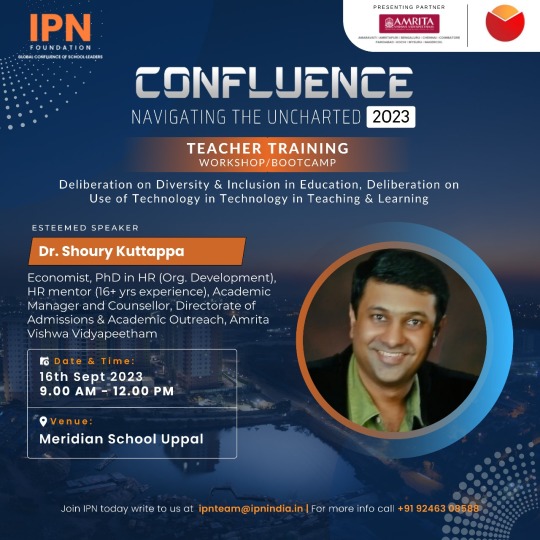
Confluence 2023: Navigating the Uncharted - Artificial Intelligence in Education and Learning held in Hyderabad was a highly successful event, bringing together principals and school directors who are committed to pioneering the future of education with technology.
Dr. Shoury Kuttappa, an esteemed expert in AI in education, was instrumental in driving the program’s impact, offering participants a visionary yet practical perspective on how artificial intelligence can enhance teaching, learning, and school leadership.
Dr. Shoury Kuttappa’s sessions focused on the core values of education—such as fostering critical thinking, creativity, and lifelong learning—while demonstrating how AI tools can support these goals by offering personalized learning, adaptive assessments, and data-driven insights to optimize student engagement and performance. He illustrated the true meaning of technology in education, emphasizing that AI serves not as a replacement but as a powerful tool that enables educators to address diverse student needs, make informed decisions, and ultimately, create a more meaningful and accessible learning experience.
Tailored specifically for school leaders, the program provided actionable strategies for implementing AI-powered platforms and insights into navigating the ethical and practical aspects of AI integration in schools. Confluence 2023 was praised by attendees for its deep insights and forward-thinking approach, equipping educational leaders with the vision and tools to lead their schools confidently into an AI-enhanced future.
#AIinEducation#FutureOfLearning#EducationAndTechnology#RedefiningEducation#21stCenturyLearning#LeadershipInEducation#TransformingTeaching#InnovativeEducation#PersonalizedLearning#SchoolLeadership#EducationalInnovation#EmpoweringEducators#AdaptiveLearning#TechnologyInEducation#GrowthMindset#LeadershipDevelopment#DrShouryKuttappa
0 notes
Text
Confluence 2023: Redefining Education with AI - Navigating New Frontiers in Learning- Vadodara
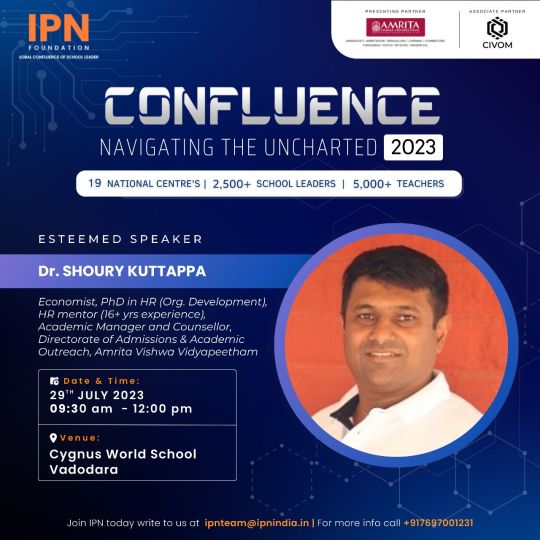
Confluence 2023: Navigating the Uncharted - Artificial Intelligence in Education and Learning was an outstanding success, providing principals and school directors with a transformative exploration of both the meaning of education and the role of technology in today’s evolving landscape.
Dr. Shoury Kuttappa, a respected authority in AI and educational transformation, played a pivotal role in guiding participants through how artificial intelligence can redefine educational goals and outcomes. His sessions highlighted how AI-driven tools can support a deeper, more personalized approach to learning, offering insights into adaptive learning systems, predictive analytics, and intelligent tutoring that bring flexibility and focus to the classroom.
Dr. Shoury Kuttappa emphasized that at its core, education is about fostering curiosity, critical thinking, and lifelong learning, while technology is a powerful tool to enrich and support this mission. By integrating AI in education, educators can expand the boundaries of traditional learning, making it more meaningful, inclusive, and accessible for each student.
The program encouraged school leaders to see technology not as a replacement but as an enhancer of the human elements of education, enabling data-driven decision-making and nurturing student engagement. Confluence 2023 provided participants with practical strategies and a renewed vision of education’s purpose, equipping them to lead schools in a digital age that prioritizes holistic student development and impactful learning experiences.
#AIinEducation#FutureOfLearning#EducationAndTechnology#RedefiningEducation#21stCenturyLearning#LeadershipInEducation#TransformingTeaching#InnovativeEducation#PersonalizedLearning#SchoolLeadership#EducationalInnovation#EmpoweringEducators#AdaptiveLearning#TechnologyInEducation#GrowthMindset#LeadershipDevelopment#DrShouryKuttappa
0 notes
Text
AI Button: Bridging Education, Technology, and Public Welfare
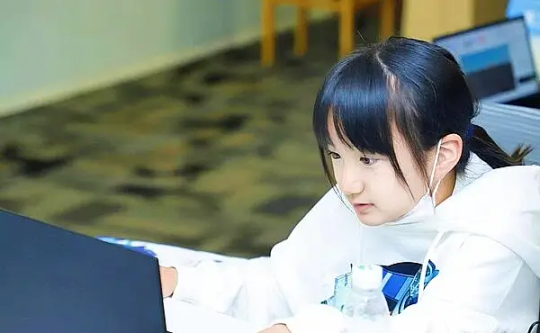
Transforming Education with AI
In an era where technology is revolutionizing every aspect of our lives, 13-year-old high school student Qiu Yumo is at the forefront of change. With the creation of AI Button, an innovative platform blending education, technology, and public welfare, Qiu Yumo has taken a significant step toward redefining learning for students worldwide. A Visionary Concept AI Button is a visionary project that underscores the importance of long-term commitment to education. As governments and international organizations increasingly strive for educational equality, the education industry is experiencing a surge in attention. UNESCO's Education 2030 Agenda, aimed at achieving global educational equity and inclusive education, serves as a testament to these efforts. The Birth of AI-Button Born from the mind of a middle school student, AI-Button represents a transformative tool platform. It harnesses the power of AI's big model to support public welfare education, seamlessly merging learning, philanthropy, and socialization. Students can utilize this platform to enhance their educational journey and contribute to societal betterment. Personalized Learning Assistance AI-Button's core functionality is its AI-powered personal learning assistant. By simply inputting their learning materials, students receive tailored guidance and advice, enhancing their learning and review processes. Whether they're consolidating previous knowledge or preparing for exams, AI-Button ensures students have access to precise materials and recommendations. This online mentor is available 24/7 and accommodates both Chinese and English languages.
Fostering Philanthropy and Social Responsibility
Beyond its educational capabilities, AI Button encourages students to engage in philanthropic activities. It seamlessly blends education, socialization, and public welfare, offering students a multifaceted experience. Students can record various public welfare projects on the platform, earning platform points for their participation. This innovative approach stimulates interest in philanthropy, fosters teamwork, and nurtures a sense of responsibility. Empowering Students AI-Button's impact on students is profound. Many have eagerly participated in online projects, finding AI-Button to be an enthusiastic learning companion. Students report increased enthusiasm for learning and engagement in public welfare initiatives. Moreover, they gain a deeper appreciation for technology's role in facilitating learning and societal progress, all while building lasting friendships.
The Remarkable Journey of Qiu Yumo
The visionary behind AI-Button, Qiu Yumo, embarked on her programming journey at the tender age of 6. By age 7, she had already developed a successful game. Qiu Yumo's fascination with AI and its transformative potential led her to explore AI's capabilities. In early 2023, she combined her passion for programming with her love for pets to create a pet pedometer, a project that garnered recognition at a school science exhibition. A Lifelong Commitment to Philanthropy Qiu Yumo's journey in philanthropy began at the age of 4 when she organized a charity sale at her kindergarten. Over the years, she consistently engaged in various philanthropic activities. Her commitment culminated in her decision to donate her hair to children with cancer on her 13th birthday. Qiu Yumo epitomizes the spirit of philanthropy, continually using her talents and creativity to make a positive impact.
A 99 Public Welfare Project
In 2023, Qiu Yumo's popular creation, AI Button, became a catalyst for her 99 public welfare project. Determined to influence more students and amplify her support for public welfare initiatives, she leveraged AI-Button's potential to make a difference. However, the journey from creating "a small tool for myself" to transforming it into a platform serving hundreds was no small feat. Collaborative Efforts Qiu Yumo's dedication inspired a team of students from different schools to join the AI-Button project. Their collective efforts spanned testing, optimization, promotion, and collaboration. Weekly meetings ensured the synchronization of their progress. After months of iterative development and refinement, AI-Button matured into a user-friendly platform, opening its doors to eager learners.
A Vision for the Future
AI-Button's ultimate goal is to seamlessly integrate technology, public welfare, and education. It aims to create a mutually beneficial learning environment, empowering students to maximize technological resources for efficient learning. This platform encourages active participation in public welfare endeavors, fostering social responsibility and teamwork while igniting an interest in technology and learning. Promoting Educational Equity Education experts applaud AI-Button's mission to provide a high-quality learning and growth environment, especially for students in underserved areas. This innovative approach embodies the potential of technology and education to promote educational equity. It showcases the creative synergy between technology and education, highlighting the sparks of ingenuity in this evolving landscape. Sources: THX News & AI-Button. Read the full article
#13-year-oldtechinnovator#AIButton#AI-poweredlearningplatform#Educationandtechnology#Educationalequitythroughtechnology#LearningwithAI#Personalizededucationassistance#Philanthropicstudentinitiatives#Philanthropyineducation#QiuYumo
0 notes
Video
youtube
On today's menu we have a very polemic subject: students' devices in the classroom. Most schools banned students devices such as cellphones from classrooms; however, in nowadays is getting harder and harder to ignore them. A couple of schools changed their polices regarding this subject and adopted the If you can’t beat them, join them slogan. Check the video out to find out their journey.
Are you ready for BYOD (bring your own device) ?
Just clarifying,BYOD is where students and staff are allowed to use personal mobile devices on school wireless network.
I’m sure you’ve already heard of it, because it’s spreading through schools faster than juicy gossip in a tiny town. Now there’s a lot to consider when determining if implementing BYOD at your school is the right move. So, here’s a list of 20 pros and cons to hopefully help make the decision a little easier on you.
Pros of BYOD
1.) Students are already familiar and comfortable using their own technology so they can focus on actually learning with them.
2.) Students’ personal mobile devices tend to be more cutting-edge, so schools can more easily stay up-to-date with technology.
3.) Students are more likely to have remembered their beloved mobile devices than textbooks or notes.
4.) It’s a cost-effective way to save schools money on technology.
5.) With BYOD students are more likely to continue learning outside of schools hours.
6.) When students use their own devices, they take care of their own ‘training.’
7.) BYOD provides opportunity for teaching respectful/appropriate use, which will be important in properly preparing them for the future.
8.) Students will be more organized with all their notes and assignments all in one place.
9.) Gives the students limitless access to information and resources.
10.) BYOD allows student & teacher to swap roles.
11.) Teachers can use certain apps to be more connected with students and parents than ever before.
12.) Students love technology so BYOD engages students and creates enthusiasm and excitement about learning.
13.) If students bring their own devices to school, schools can concentrate funding on the students who need it, maybe providing an iPad leasing program.
14.) BYOD allows more opportunities for more personalized learning where students can excel at their own pace.
15.) Students take control of ensuring that their device is working, instilling a sense of responsibility.
16.) BYOD offers a way of delivering ebooks.
17.) There are loads of cool and exciting educational apps to get students excited about learning.
18.) The majority of students and adults already own the devices necessary for BYOD.
19.) Students can use the device they have chosen to complete their tasks so they are more likely to do them.
20.) BYOD can be used as a privilege to encourage students to stay on task.
Cons of BYOD
1.) All these mobile devices can overload your wireless network.
2.) It possibly opens up the opportunity for cheating.
3.) Technology may become a status symbol for students causing the divide between the haves and have not’s to be even greater.
4.) Parents may not be happy with the idea of paying for mobile devices for use in school.
5.) Students may be more easily distracted while working on their own mobile devices.
6.) Students might forget to charge their devices.
7.) Students bringing in their own devices to school may increase the possibility of theft.
8.) Students may not be able to afford these devices.
9.) What if a student brings a virus from home onto the school wireless network?
10.) It can be more challenging for an IT department to manage the bandwidth required to ensure all devices are connected and running smoothly.
11.) Students forget to bring their mobile devices.
12.) Applications may not be universal across all platforms.
13.) Your wireless network infrastructure may need to be addressed before implementation.
14.) Just like some of the parents, some of the students may not to mix in school work on their personal mobile devices.
15.) Some teacher may resist teaching with technology.
So we have 20 pros and 15 cons…looks like the pros for BYOD are beating out the cons here. Even with all 15 of these cons, I still think a lot of the pros hold a lot more value and therefor out weight most of the cons of BYOD anyways. Plus, many of these cons can be avoided or fixed with certain policies, apps, the correct network infrastructure, and mobile device management.
What is your opinion about BYOD?
Source:http://www.securedgenetworks.com/strategy-blog/20-Pros-and-Cons-of-implementing-BYOD-in-schools
If you want to know more information about BYOD implementation here are some more information and links:
http://www.securedgenetworks.com/security-blog/How-to-Plan-a-BYOD-Security-Policy-for-Schools
http://www.securedgenetworks.com/ebook-ipads-in-the-classroom
http://cdn.nmc.org/media/2014-nmc-horizon-report-k12-EN.pdf
#BYOD#bringyourowndevice#school#educationandtechnology#tech ed#McGill#edpe640#educacaoinclusiva#education#inclusive education#inclusion#cellphone in school#ipad#iphone
0 notes
Video
vimeo
On today's menu we have Nearpod
I'm from the time where teachers didn't use powerpoint presentations or even had computers in the classroom. I'm getting old I guess... however, I've seen those changes coming along the way as technology started to be more reachable to the main public. Today, we have computers in every classroom, projectors, some schools has smart boards but what about iPads, cellphones? Should they be permanently banned in each school?
I've learned in one of my classes this absolute AMAZING app called NEARPOD. It revolutionized everything that I knew in terms of presentation! Forget powerpoint, even Prezi. Nearpod is a platform that enables not only teachers but any type of speakers to use their Tablet to manage content on students' or any audience mobile devices. It combines presentation, collaboration, and real-time assessment tools into one integrated solution. It's suitable for pcs, macs, iPhones, iPads, androids are suitable as well and is FREE!!!!!
This app that has been used by more than 2.000.000 students around the world and I got surprised because I only got to know this tool a couple of weeks ago.
We can create our own presentations and download ready-to-use lessons from distinguished publishers and educators, we can engage students and audience with the interactive features also is possible to monitor the classroom activity and easily control students' or audience devices.
We can get immediate feedback and track the class's progress with detailed reports assessing in real time!
Please watch the video and you'll be amazed of how easy is to change perspective of having technology in a classroom to benefit both, students and teachers.
If you want to know more information about check those links:
http://www.nearpod.com/#
http://vimeo.com/110259855
http://youtu.be/ECwPmGbyaVE
http://vimeo.com/nearpod
http://youtu.be/TRBGnCzp5NY
Nearpod- portuguese version
Eu sou do tempo em que os professores não PowerPoint ou se quer computadores na sala de aula. Estou acho que estou ficando velha ... no entanto, eu vi essas mudanças acontecendo ao longo do caminho onde a tecnologia começou a ser mais acessível para o público em geral. Hoje, temos computadores em cada sala de aula, projetores, algumas escolas tem smartboards, mas o que dizer de iPads, celulares? Será que eled deveriam ser banidos permanentemente nas escola?
Eu aprendi em uma das minhas aulas como usar essa aplicação surpreendentemente revolucionária chamada NEARPOD. Ela revolucionou tudo o que eu sabia em termos de apresentação! Esqueça o powerpoint, mesmo o Prezi. Nearpod é uma plataforma que permite não só professores, mas qualquer tipo de apresentador, usar seu Tablet para gerenciar conteúdo dos estudantes e ou audiência ou qualquer dispositivo móvel. Ele combina apresentação, colaboração e ferramentas de avaliação em tempo real em uma única solução integrada. É apropriado para PCs, Macs, iPhones, iPads, andróides e é GRATUITO !!!!!
Este aplicativo, que tem sido utilizado por mais de 2.000.000 alunos em todo o mundo e me surpreendi porque eu só vim a saber sobre esta ferramenta a algumas semanas atrás.
Nós podemos criar as nossas próprias apresentações e baixar lições prontas para utilização de autores ilustres e educadores, podemos envolver os alunos e o público com os recursos interativos também é possível monitorar as atividades de sala de aula e facilmente controlar os alunos.
Nesses links tem mais information sobre o assunto:
http://www.nearpod.com/#
http://vimeo.com/110259855
http://youtu.be/ECwPmGbyaVE
http://vimeo.com/nearpod
http://youtu.be/TRBGnCzp5NY
http://youtu.be/EAGAkLxiKAs
http://youtu.be/sKNr1NLb6oc
http://youtu.be/KP4Y1hJt2Lk
http://youtu.be/rtvFkeB9gwk
http://youtu.be/_v0x7YcWqMA
http://youtu.be/_Mh8iSjO1Ok
http://youtu.be/2NX6IkFZ1nU
http://youtu.be/qkO5T5MOXN4
#edpe640#educationandtechnology#teched#technology#educacaoinclusiva#education#educação#nearpod#101#inclusiveeducation#McGill#mcgill university#Canada#montreal
0 notes